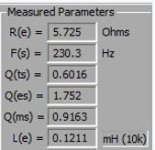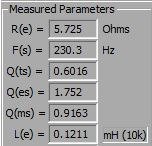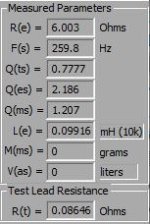Depends if they cross over at 3,5kHz or lower 🤓there is many decent speaker with 1" dome and 3inch medium tweeter , Dynaudio, Atc , Cello etc.. do you think they have all done wrong ?
Crossing so high has one benefit - SPL level! Musical content goes doen in power requirements >2kHz and as a 1" tweeter can't compete with the midrange it helps to keep it alive with real music material (not measurement signals).
https://www.hifi-selbstbau.de/index...hnik/musik-qvergleichenq-mit-dem-waveanalyzer
The term "wrong" (or "right") is misplaced. The 3" to 1" transition represents a compromise, albeit one that has minimal audible consequences in many applications. It might be helpful here to understand a little of the history of the 3" dome, and how it became so commonplace in high performance audio systems.there is many decent speaker with 1" dome and 3inch medium tweeter , Dynaudio, Atc , Cello etc.. do you think they have all done wrong ?
The 3" dome as we would recognise it today was developed in the early 1980s by ATC. Its uniqueness was not simply being a large dome with a bandwidth favourable for vocal reproduction: It also incorporated many of the manufacturing techniques that ATC had employed in their bass drivers to enable reliable and relatively high power operation.
At much the same time, Sony and Philips developed the compact disc which, despite a few drawbacks, offered a substantial increase in the dynamic range available in sound recording and reproduction. The appearance of the 3" dome then turned out to be rather timely, because it offered recording and mastering professionals a significant advance in the level of reproduction quality.
Most critical here was the ability of the 3" dome to cope with the large dynamic range with low distortion. High SPLs were now possible from a direct radiator without the horn resonances typical of many studio installations at the time. Overall, the 3" dome's mid range reproduction quality was surpassed only by electrostatic loudspeakers, where design compromises in the latter became clearly evident with such dynamic range demands.
And so a new paradigm was set in place in professional applications of high powered, direct radiating active loudspeakers based around the 3" dome. In some cases, ATC sold their 3" to other manufacturers, whilst other manufacturers developed their own 'lookalike' drivers. Domestically too, performance advantages were evident, although here the existing paradigm of passive loudspeakers provided a significant barrier to the acceptance of active loudspeakers (largely one suspects due to the increased sales incomes from selling stand-alone amplifiers too).
Despite advancements in technology since the 1980s, the 3" dome remains ubiquitous in the professional audio arena. Genuine improvements in its performance have not been common and tend to introduce other compromises - using stiff diaphragm materials, for example. The biggest advancements (and common to all moving coil drivers) has been the availability of better magnets and the developments of techniques to limit magnetic non-linearities - even to the point where the mid range advantages of electrostatic loudspeakers are now questionable.
Compromise is inevitable and remains so to this day. The 3" to 1" transition is one such compromise that has a relatively benign effect in professional listening environments. In domestic settings, where rooms are likely to be more reflective, and where dynamic range is often already compromised by the source material, this compromise might be considered more problematic: In most cases, it appears not.
Last edited:
Scanspeak D7608-920010 - TS params & low end XO freq
I measured my existing D7608's enclosed - ~1.5L, 12mm mdf, lined 5 sides with egg crate foam.
DATS V3 data attached along with orig free air measurements. (unsure of #1 vs #2 enclosed without removing the drivers)
Currently crossing my 3ways around 950Hz (& 5.2kHz) but reckon I have heard mids sound better crossed lower.
The last speakers I used them in, ages ago, crossed them at 500Hz 3rd order (elec) XO - yeah I know, too low on paper. They sounded good however. Not aware of noticeable distortion - but I don't listen at high levels.
The design those were based on is shown here:
https://www.stereonet.com/forums/topic/93512-vifa-sa-130-plans-specs/
it crossed them at 800Hz 3rd order (elec).
Any ideas how low I could cross them & still get say 90dB at 3 meters ? (given I've got mid Qtc's around 0.75)
I measured my existing D7608's enclosed - ~1.5L, 12mm mdf, lined 5 sides with egg crate foam.
DATS V3 data attached along with orig free air measurements. (unsure of #1 vs #2 enclosed without removing the drivers)
Currently crossing my 3ways around 950Hz (& 5.2kHz) but reckon I have heard mids sound better crossed lower.
The last speakers I used them in, ages ago, crossed them at 500Hz 3rd order (elec) XO - yeah I know, too low on paper. They sounded good however. Not aware of noticeable distortion - but I don't listen at high levels.
The design those were based on is shown here:
https://www.stereonet.com/forums/topic/93512-vifa-sa-130-plans-specs/
it crossed them at 800Hz 3rd order (elec).
Any ideas how low I could cross them & still get say 90dB at 3 meters ? (given I've got mid Qtc's around 0.75)
Attachments
Indeed, as I noted in post 435, datasheet has Qms of 7.75. Something's very odd about measured values of 0.91.
ok so i understand that mixing the MP74S with the T25S will be a compromise except crossing them at 2khz ?Depends if they cross over at 3,5kHz or lower 🤓
Crossing so high has one benefit - SPL level! Musical content goes doen in power requirements >2kHz and as a 1" tweeter can't compete with the midrange it helps to keep it alive with real music material (not measurement signals).
https://www.hifi-selbstbau.de/index...hnik/musik-qvergleichenq-mit-dem-waveanalyzer
No, it is always compromise. As already stated in this thread, picking 2kHz will further compromise peak and rms SPLs. There are no right answers.ok so i understand that mixing the MP74S with the T25S will be a compromise except crossing them at 2khz ?
i don't understand why a company would make a Tweeter dome and medium dome if not to make complementary drivers ?
Even what you refer to as "complementary" drivers would involve a compromise simply because there is more than one.i don't understand why a company would make a Tweeter dome and medium dome if not to make complementary drivers ?
no free lunch full range drivers are too , as you seem expert in the matter of compromise what size of bass driver will you marry with a 3inch dome 8 , 10 or 12 inch ?
depends.....😀what size of bass driver will you marry with a 3inch dome 8 , 10 or 12 inch ?
, i have a too big speaker for my room with 15inch Tad driver , 55cm diameter wood horn and fostex tweeter , and i would like to build a more compact system 2 or 3way for low to medium level listening with the best quality drivers for this task. simple 😆
for the moment i have sourced Bliesma T25s with MP74S medium dome and a 8inch or 10inch purifi woofer in closed box , but i'm open to other suggestion
for the moment i have sourced Bliesma T25s with MP74S medium dome and a 8inch or 10inch purifi woofer in closed box , but i'm open to other suggestion
IME there is no problem with any of those diameter drivers. Obviously the larger driver would permit greater displacement and therefore the potential for greater LF extension. And a 12" driver with an appropriately designed dust cap can provide a better sound power output response in the HF crossover region than a simple deep coned 8" driver.no free lunch full range drivers are too , as you seem expert in the matter of compromise what size of bass driver will you marry with a 3inch dome 8 , 10 or 12 inch ?
Once again, however, there is no generic "right" answer, since there are far more variables to consider if we add in bass driver selection too, and therefore more than one simple question to ask or try to answer.
i have tried to mix a 15inch JBL2216 with a 3inch Yamaha berrilum dome and never succeed to mix them right even the TAd 1601 that i use now don"t shine above 400hz
You have different options with Bliesma.
*) When a 1" tweeter gives enough SPL (what it does in MOST situations) - you can use it. Crossed over at 2kHz you have even and wide off axis behaviour, crossed at 3,5kHz you can achieve louder SPL with music. With an proper active crossover I prefer the lower crossover frequency, with a lower order passive without delay compensation ... I would give it a listen.
*) You can combine the T34 with the 3". Gives about 6db more MaxSpl and you can cross even lower if desired. T34A has very wide radiation >10kHz, no compromise here. B model has higher sensitivity and higher membrane resonance. THD is higher at low levels as with the 1" model btw.
There are not many 12" which behave enough to cross to an 3" midrange. But there are some.
I use 2 long stroke 12" with good sensitivity - and they are still limiting maximum SPL compared to one 3" midrange.
You always can go with smaller speakers - with 2 8" you can fall back to the 1" tweeter again ... ;-)
*) When a 1" tweeter gives enough SPL (what it does in MOST situations) - you can use it. Crossed over at 2kHz you have even and wide off axis behaviour, crossed at 3,5kHz you can achieve louder SPL with music. With an proper active crossover I prefer the lower crossover frequency, with a lower order passive without delay compensation ... I would give it a listen.
*) You can combine the T34 with the 3". Gives about 6db more MaxSpl and you can cross even lower if desired. T34A has very wide radiation >10kHz, no compromise here. B model has higher sensitivity and higher membrane resonance. THD is higher at low levels as with the 1" model btw.
There are not many 12" which behave enough to cross to an 3" midrange. But there are some.
I use 2 long stroke 12" with good sensitivity - and they are still limiting maximum SPL compared to one 3" midrange.
You always can go with smaller speakers - with 2 8" you can fall back to the 1" tweeter again ... ;-)
Creating a good speaker with this stuff will mainly depend on your skill and patience when using for example a Hypex Fusion 3way with DSP., i have a too big speaker for my room with 15inch Tad driver , 55cm diameter wood horn and fostex tweeter , and i would like to build a more compact system 2 or 3way for low to medium level listening with the best quality drivers for this task. simple 😆
for the moment i have sourced Bliesma T25s with MP74S medium dome and a 8inch or 10inch purifi woofer in closed box , but i'm open to other suggestion
I would suggest instead you measure what you have built every which way you can, until you can identify what exactly it is that is not working as you desire. There are many useful such contributions in this forum to help. The recommendation above to experiment patiently with a DSP crossover is a good one, for example.i have tried to mix a 15inch JBL2216 with a 3inch Yamaha berrilum dome and never succeed to mix them right even the TAd 1601 that i use now don"t shine above 400hz
Also, as I mentioned above, there is much to be found in examining current dependent non-linearities. Seldom encountered in this forum too are effects evident in stereo listening due to phase anomalies, especially in the 2-3kHz region - the latter being another reason why 3.5-4kHz crossovers can be preferable. And so the list goes on...
But remember that your considerations should encompass peak SPLs if you are looking for high fidelity reproduction. Without sufficient peak SPL output capability, loudspeakers systems sound subjectively dull regardless of all other design specifics. This is one fact I state without compromise.
- Home
- Loudspeakers
- Multi-Way
- The dome midrange thread



